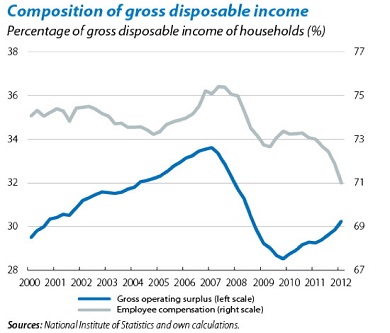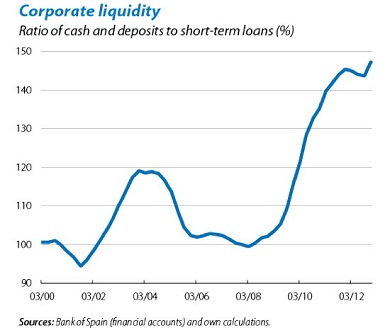Domestic demand is the hardest hit by the far-reaching adjustments being made by the Spanish economy. Since the recession started in 3Q 2008 and up to 1Q 2013, it shrank by 14% in real terms and the outlook is not very promising. Domestic demand is unlikely to pick up until the deleveraging process has been completed. However, the supports for consumption and production investment will gradually get stronger over the coming quarters.
Private consumption has accumulated a fall of 7.6% but its rate of decline has lessened in the last quarter (-0.4% in 1Q 2013 vs. -1.9% in 4Q 2012). However, part of this improvement is due to the reversal of the effect of the VAT hike in September 2012 and, moreover, the situation of the job market does not augur a very rapid recovery. Nevertheless there are at least three factors that will help to stabilize private consumption in the coming quarters:
– Household savings: in spite of being at historically low levels (8.1% of the gross disposable income of households in 2012), the savings rate could still fall by an additional one to two percentage points.
– Gross disposable income of households: although it is true that employee wages will remain weak, non-wage income has better prospects thanks to the rise in the number of self-employed workers and the improved gross operating surplus generated by their activities.
– Financing costs: the ECB’s recent cut in the official interest rate as well as its promise to keep to an expansionary monetary policy for a prolonged period of time will make the deleveraging process easier to bear.
Like household consumption, investment in capital goods saw a notable improvement in 1Q 2013 compared with the preceding quarters (0.1% in 1Q 2013 versus -5.2% in 4Q 2012). However, unlike consumption, historically investment used to exit recessions with a rapid improvement in its growth rates. Will it be the same this time? We can identify two factors that will help to revive corporate investment:
– Cash hoarding: a growing number of firms are accumulating liquid assets on their balance sheets. Such excess savings are a precautionary measure given the uncertainty regarding the economic climate and access to sources of financing. As the economic situation improves and uncertainty diminishes, these firms will be in a good position to invest.
– Financing costs: since July 2012, the interest rate on Spain’s 10-year sovereign bonds has fallen by 2.6 percentage points. Over the coming months, changes in the cost of public debt will gradually be passed on to interest rates for business loans. The effect this might have on investment is quite considerable: according to the Bank of Spain’s estimates, for each percentage point the interest rate falls, investment rises by 1.5 points.
In short, to achieve a sustained economic recovery, it is essential for domestic demand to pick up. This year it will probably still be depressed but the points of support that are being forged, and which should consolidate over the coming quarters, give us reason to believe that its recovery is close at hand.








Be the first to comment on "Guide to support the Spanish domestic demand"